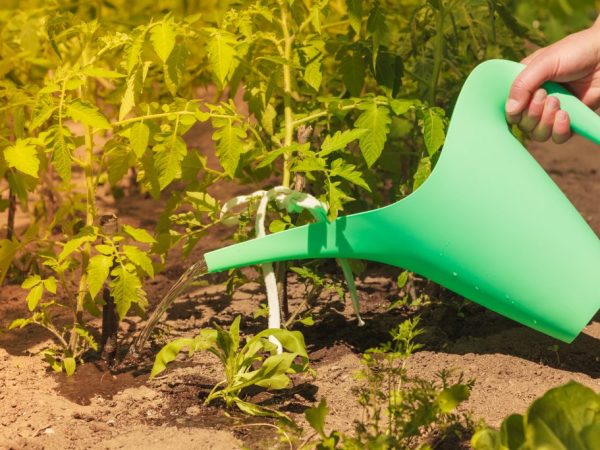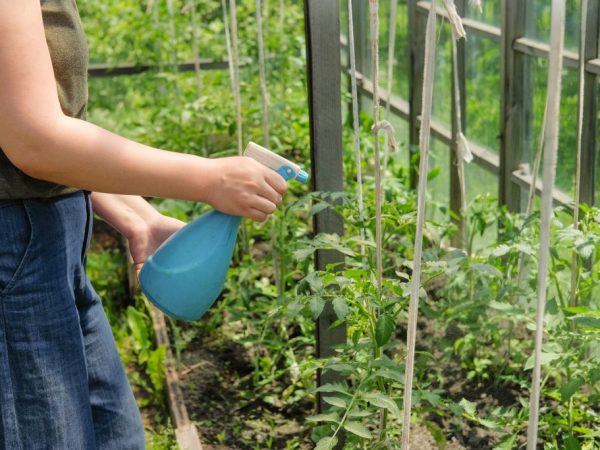The effectiveness of feeding seedlings with iodine
The possibility of obtaining a high-quality tomato harvest is a reality, but only if the plants are properly looked after. It is possible to ensure that they are healthy and bear fruit with the help of iodine. This medication has proven itself well and is extremely beneficial. Feeding seedlings with iodine can be carried out both in the greenhouse and in the open field, and in each case, feed the tomatoes, helping the plants to strengthen.

The effectiveness of feeding seedlings with iodine
Why do tomatoes need iodine
According to experts, feeding tomatoes with this substance helps to increase the yield and improve the appearance of plants. In addition, being an antiseptic, iodine becomes an excellent method of fighting bacteria, pathologies, and even some pests. In addition, iodine:
- protects crops from fungi;
- strengthens the immune system and serves as a prophylaxis against diseases;
- replaces saltpeter and acts as a fertilizer;
- forms a high-quality ovary and enriches the soil, making it more fertile.
Iodine for tomato seedlings should be used even if the plants are healthy and bear fruit well. However, if there is a shortage of this element, then you can notice this problem immediately, since the seedlings:
- looks stunted;
- has thin stems;
- can get sick with root rot, late blight and other things.
Understanding the importance of using iodine for tomatoes, you need to learn how to do the feeding procedure correctly and regularly. There are two ways to apply iodine - root and foliar, each of which should be alternated with each other. This allows you to achieve both therapeutic and prophylactic effects that persist for a long time.
The root method of applying iodine
The use of root watering with this important trace element is recommended for the first time when the seedlings release a couple of leaves. It is necessary to prepare a solution that will feed the plant well. Experienced gardeners suggest using 3 liters of water mixed with 1 drop of iodine for irrigation. Although the solution appears to be low in concentration, it nourishes young plants excellently. In order for tomatoes to receive their necessary portion of nutrients, you need to water each plant to the very root. The benefits of such manipulation are doubled due to the fact that, together with iodine, the seedlings receive the water necessary for their life.
After a while, you can make a second top dressing. Iodine for tomato seedlings is used at the stage of the ovary. It is recommended to change the recipe for the solution: now the drug is diluted according to the scheme of 3 drops per 10 liters. warm water. It is recommended to water about a liter of solution under each couscous, and if the plant belongs to undersized varieties, then 700 ml is enough for it.
The third root dressing is carried out in the phase when the seedlings begin to bear fruit. In this case, gardeners recommend using an even more concentrated iodine-based solution.For watering, you need to use about 3 liters of ash powder, which is added to 5 liters of hot water and immersed in a container. Covering the solution with a lid, let it brew for about an hour. Then another 5 liters are added. water, after which it is recommended to pour in a bottle of iodine and 10 g of boric acid. The "ingredients" placed in the liquid must dissolve well in the water, so it is important to mix them. Means with iodine for tomato seedlings need to be insisted for a day. After the specified time has elapsed, it is necessary to dilute the infusion again from a proportion of 1 liter. iodine agent per 1 liter. water. Water the tomatoes to the root. This will help the bushes bear fruit better and strengthen their immunity.
Foliar method

Spray plants very gently
The ability to feed tomatoes can be carried out not only at the root, but also by the foliar method. This is especially true in the fight against late blight and other diseases that can affect leaves, shoots and stems, making seedlings fragile, weak and unstable to bacteria and parasites. Iodine is a top dressing for tomato seedlings, which will never fail at the correct dosage.
For watering, you need to dilute 5 drops of iodine with a glass of milk and 1 liter of warm water. It makes sense to try another recipe: 4 liters of warm water is mixed with 1 liter of milk or whey, and then 15 drops of iodine are added. The resulting solution must be mixed well and used as a spray. The optimal time of day is early morning or evening, after sunset. The day should be calm and dry, otherwise the rains will simply wash away the watering and make it ineffective. It is impossible to spray heavily on the plants, since this can lead to harm, and not the benefits that are so necessary for the seedlings. Reviews say that it is important not to increase the amount of iodine, otherwise you can get not a fruiting plant, but tomatoes with burnt leaves and a damaged vegetative system.
In order to avoid late blight, you need to water the seedlings with iodine about once every 15 days. If you use only milk, without using an iodine solution, then you can spray the plants with it much more often, up to daily treatment. Formula improves the growth of vegetables, strengthens them and nourishes them well. It is recommended to alternate the treatment of leaves with serum without iodine with solutions based on this beneficial element.
If you nevertheless find the first signs of late blight in tomatoes, you need to increase the dosage of the agent so that the effect of the treatment is as noticeable as possible. To fight the disease, you need to take 1 liter of milk whey, 40 drops of iodine and 10 liters. water. We'll also have to add 1 tbsp. l. hydrogen peroxide. After stirring the "ingredients", you need to water the seedlings with them and observe how the plants behave. It is important to do this carefully, taking care that the leaves are well saturated on all sides. Ideally, after processing, the bushes are wet and liquid will drain from them.
When feeding, aimed at getting rid of late blight, it is also worth using a gentle recipe, which can be used more often than in the case of prevention. To do this, you need to take 250 g of milk, 1 liter of water and a couple of drops of iodine. This solution can be used to process seedlings every two weeks.
Tips from experienced gardeners for proper iodine feeding of tomatoes
In order for the processing of tomatoes to be successful, and the seedlings to receive the saturation they need, you need to adhere to the rules tested by experienced farmers.
- You cannot use iodine or any other elements if the seedlings are in the ground for no more than 10 days. The thing is that after a pick, tomatoes, like any other plants, get stress, and they need to get used to a new place in which they will grow and develop.
- Iodine concentrate should be added with serum for 1 month with an interval of 3-4 days, if there is a need to treat already diseased tomatoes. In case of prophylaxis, you can do it once a quarter.
- When phytophthora appears, spraying should be increased, and it is desirable to make the solution as concentrated as possible.
- If you are working with an iodine-based solution, you do not need to use medications such as aspirin. The best option would be a mixture of grains of manganese with iodine at the rate of 100 ml of the product for 0.5 crystals.
- Intending to water tomatoes with boric acid or hydrogen peroxide, you need to remember that this is done only 4-5 days after spraying with iodine. Otherwise, the effect of the iodine solution will be minimized and the tomatoes will not receive all the nutrients they need.
- When adding milk with iodine against phytophthora in tomatoes, you should take only a low-fat dairy product, which mixes much better and combines with iodine-based preparations.
Now you know how to water your plants for a blooming look and a rich harvest. You can prepare a solution for tomatoes at home, so you should take this opportunity. With the correct dosage and infrequent, but competent feeding with iodine, tomatoes will answer you with productivity and health.


